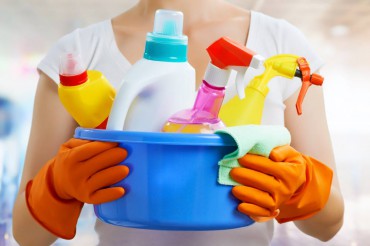
Do you know what ingredients are in the cleaning products you buy? Probably not, as there are no federal governmental regulations requiring companies to disclose their contents.
But harsh chemicals can take their toll on the indoor air quality of your home, are harmful to the environment and may irritate eyes and skin.
How can you learn more about the cleaning products you plan to purchase? Luckily, certain retailers are making it easier for consumers to make informed decisions. For example, in 2011 Whole Foods Market introduced the Eco-Scale Rating System, which are the first household cleaner standards offered by a retailer.
This season, don’t just spring clean your home; take stock of your cleaners and clean up your entire act. By opting for green cleaning products, you can help make your home a safer, healthier place. Here’s how:
DO AN AUDIT
Take a look at the cleaning products you currently own. Just because a brand or product is well known does not make it a healthy option.
A quick online search can reveal the safety attributes of a product’s ingredients — so long as the manufacturer has chosen to disclose ingredients. Toss anything problematic and make a shopping list of what you need to replace.
FULL DISCOLSURE
Avoid cleaning products that don’t disclose what ingredients they use. Look for brands, such as 365 Everyday Value, that make it easy for you to know what ingredients are being used in the product you’re purchasing.
BE INFORMED
Know what ingredients to avoid entirely. Harsh ingredients like formaldehyde and chlorine can still be found in cleaning products today.
Don’t know where to start? Take a look at the list of more than 40 ingredients that aren’t allowed in Whole Foods Market’s cleaning products, including chlorine, formaldehyde, phosphates, phthalates and triclosan.
LOCK-UP
No matter the contents of your cleaners, it’s good practice to keep them stored in a safe place, such as a locked cabinet. Young children and pets should not be able to access your cleaning products supply.
DO IT YOURSELF
A quick and easy way to know exactly what’s in your cleaning products is to make them yourself. Luckily, only a few inexpensive ingredients are needed to make your own all-purpose cleaner.
Simply mix one part water with one part vinegar, add a few drops of your favorite pure essential oil, and you have an all-purpose spray. Baking soda is another great cleaner that has a mild scrubbing power and helps combat odors.
Don’t have the time to make your own cleaner? The Eco-Scale Rating system evaluates products for environmental impact, safety, efficacy, source, labeling and animal testing. Visit WholeFoodsMarket.com/ecoscale to learn more.
If you’re using conventional cleaning supplies, you may be exposing your family to harmful ingredients. By learning more about the products you use, you can green your spring cleaning for a healthier home.





















Comments